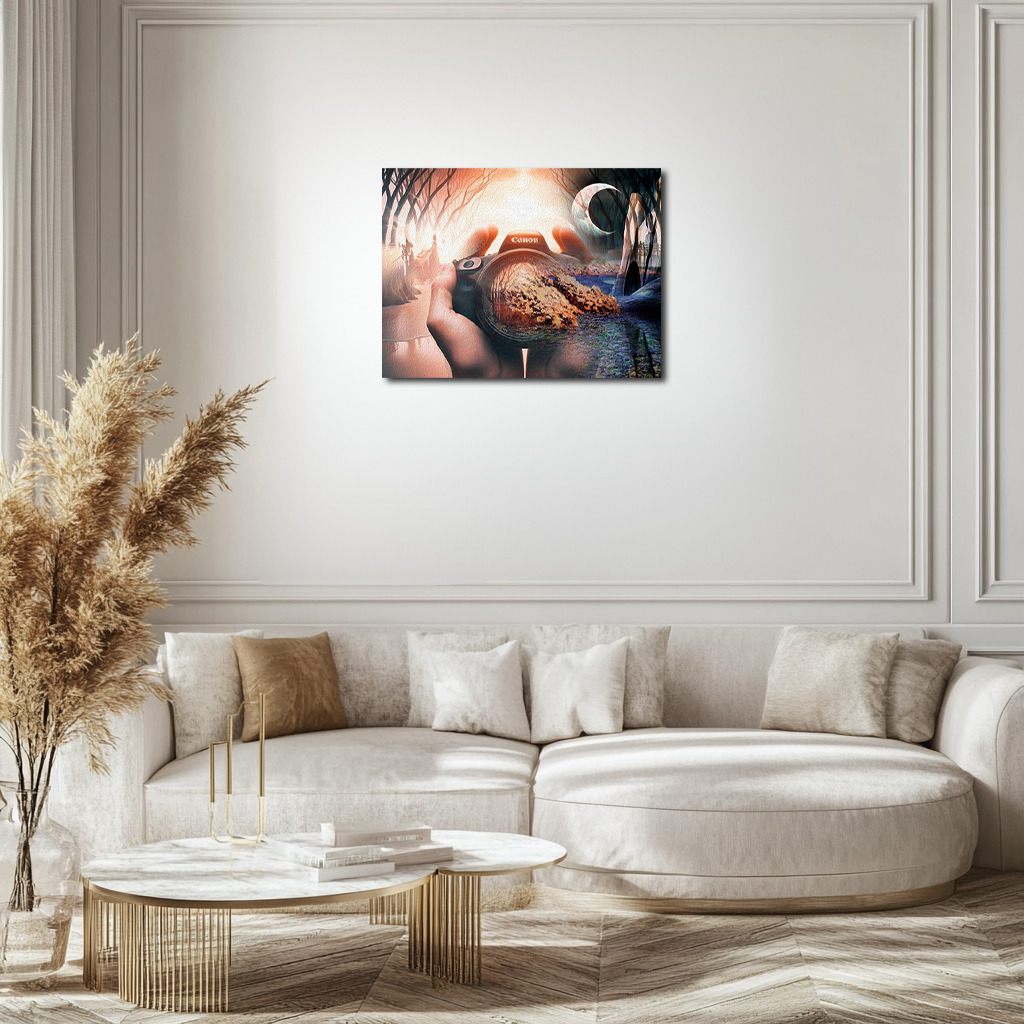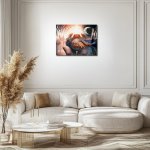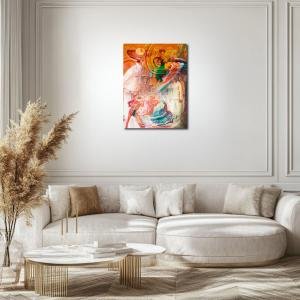Captured Reality: The Lens of Memory and Time
"Captured Reality" transforms Monet’s Rocks on the Mediterranean Coast into a meditation on perception, memory, and artistic representation. A modern camera lens refracts the golden Mediterranean landscape, raising questions about whether photography preserves or distorts reality. Ghostly trees, a fragmented moon, and a surreal castle contribute to the dreamlike atmosphere, emphasizing the fragility of memory. The contrast between warm golden hues and deep blue shadows reinforces the tension between fleeting light and eternal time. By merging modern technology with Monet’s Impressionist landscape, this piece redefines the way we capture and interpret the world, blurring the line between art, memory, and the passage of time.
Please see Below for Details…
Hotline Order:
Mon - Fri: 07AM - 06PM
404-872-4663
Claude Monet’s Rocks on the Mediterranean Coast originally focused on the interplay of light and texture along the rugged, sunlit shores of the Mediterranean. In this surreal and conceptual reimagining, the essence of Monet’s Impressionist touch is preserved, yet the scene is transformed into a reflection on perception, memory, and the distortion of reality through the lens of human experience.
At the heart of this composition, a hand holds a modern Canon camera, its lens capturing and refracting the golden Mediterranean landscape. The viewer is immediately drawn into this layered reality—where the camera does not simply record an image but distorts, reshapes, and immerses the scene within its glass. This presents a paradox: is the camera capturing reality, or is it projecting the vision of the observer? The question of whether photography preserves or alters truth is central to the emotional weight of this piece.
Surrounding the camera and Mediterranean rocks is an ethereal world infused with dreamlike elements. The trees in the background stand tall yet ghostly, as if they belong to another plane of existence, bridging the divide between physical and abstract realms. Their elongated, curved forms mirror the organic brushstrokes Monet used to convey the shifting quality of light. Their presence suggests that even nature is fluid, subject to the distortions of memory and interpretation.
To the right, a fragmented, crescent-shaped moon hangs low in the sky, casting a soft glow upon a surreal medieval structure. The architecture, resembling a forgotten ruin, evokes themes of time, history, and the erosion of memory. The broken moon reinforces the notion of partial truths—of seeing only fragments of reality, much like how a photograph captures only a sliver of a moment while the rest of time flows on, unseen.
Color plays an integral role in conveying the mood of the piece. The dominant golden hues of the Mediterranean coast contrast against the deep blues of the sky and water. Monet’s original painting emphasized light and warmth, capturing the ephemeral nature of a sunlit rock face. Here, that warmth is preserved but juxtaposed against the cooler, surreal elements, reinforcing the tension between reality and illusion. The blue tones of the water, though rich and inviting, have an almost melancholic quality, suggesting a depth beyond what the eye perceives.
As an artist, my intention in creating this conceptual work was to explore the theme of captured moments and their transformation over time. Photography, much like Impressionist painting, is an attempt to preserve fleeting light, yet both mediums are inherently subjective. What the lens sees is not necessarily what the eye sees. This piece invites the viewer to question: do we remember things as they were, or do we reconstruct them through layers of perception and emotion?
The presence of the hand holding the camera is significant. It implies the presence of an unseen observer—someone who is not only capturing the scene but also shaping its narrative. The viewer is placed in the position of both artist and subject, reinforcing the idea that art is as much about perspective as it is about representation.
Additionally, the fusion of modern technology with Impressionist elements suggests a dialogue between past and present. Monet sought to capture the immediacy of light and movement, breaking free from traditional, static compositions. This piece extends that dialogue into the digital age, where images are no longer just paintings or photographs but hybrid realities—constructed, altered, and reimagined.
The fragmented moon and surreal castle serve as metaphors for memory and time. Much like how ruins tell stories of the past, our recollections are often incomplete, shaped by the gaps and distortions of our minds. The dreamlike quality of these elements emphasizes that what we see is rarely the full picture; reality is fluid, changing with each glance, each thought, each attempt to preserve it.
Ultimately, this work challenges the notion of objective truth in art. Monet’s Impressionism was revolutionary in its departure from rigid realism, favoring subjective perception over precise detail. Here, that philosophy is extended into a conceptual realm where photography, painting, and imagination merge into a singular vision—one that questions, rather than defines, the nature of what is real.
Add your review
Your email address will not be published. Required fields are marked *
Please login to write review!
Looks like there are no reviews yet.








